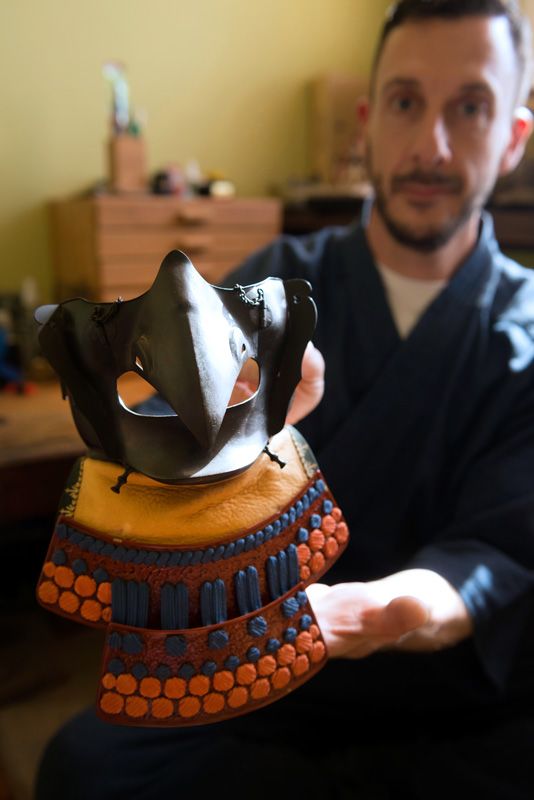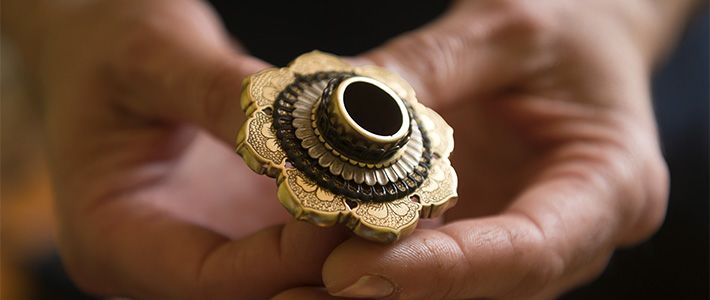
“Cool Traditions” Stay in Tune with Modern Life
Craftsman Robert Soanes: Restorer of Samurai Armor
Culture- English
- 日本語
- 简体字
- 繁體字
- Français
- Español
- العربية
- Русский
I carefully peruse the impeccably printed business card in my hand. Written on it in elegant script is: “Robert A Soanes. Specialist restoration of Japanese swords, armour and antiques.”
Soanes’s home is the English seaside resort of Brighton, a setting admittedly rather more Agatha Christie than Tokugawa Ieyasu. I ask if it ever strikes him as incongruous to be working as a samurai armor restorer there. He thinks for a second. “I never think of it as unusual,” he replies. “It is just what I have done for years.”
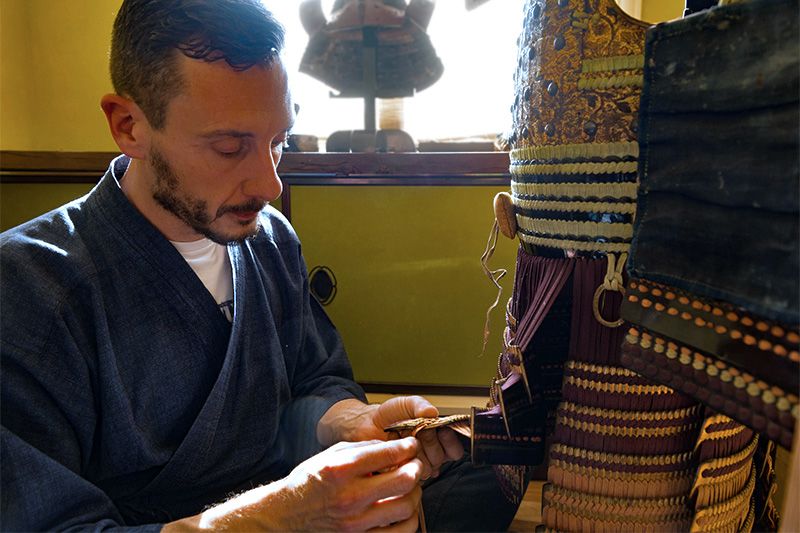 Soanes works on the lacing of a set of armor.
Soanes works on the lacing of a set of armor.
Sitting on the Floor by a Window
Almost 30 years ago Soanes began his craftsman career as a blacksmith then turned his hand to craft metalwork. Today, he works exclusively on Japanese antiques, particularly armor and sword fittings but also on other fine art, including jizai okimono (articulated iron animal figures), kintsugi restoration, ceramics, and even work on objects as small as netsuke.
Soanes’s home doubles as his workshop. It is immaculately clean with more than a hint of Japanese aesthetic in the décor. Soanes’s studio is upstairs where he works sitting on the floor by a large window.
Is that how he learned in Japan, I ask? It is, he replies. “[But] the other reason [for sitting on the floor] is that if you are working with something like ceramics and it falls, it is less likely to break.” Needless to say, Soanes never puts that to the test with the precious objects in his care.
At any one time Soanes is likely to be working on several pieces. As well as museums and auction houses, his clients include private collectors from around the world. Typically they will send the commissions to the house in Brighton by FedEx or via their own private couriers. (“It is up to the sender to pack it correctly,” Soanes notes.) Other times he might be invited to work on the pieces in situ. Recent commissions have taken him to Thailand and Hong Kong.
One of a Handful of Full-Time Armorers
Soanes is one of a small and select group of craftspeople. He estimates that there are only four or five armorers working full time in Japan, including Nishioka Fumio, with whom Soanes has studied and collaborated. He is, as far as he knows, the only full-time armor restorer working in Britain.
Soanes explains how up to and during the Edo Period (1603–1868) there was probably a certain amount of division of labor when making armor. Today, armorers must be experts in numerous Japanese crafts, such as metalwork, leatherwork, and lacquerwork, although they may still have a particular area of special expertise. In Soanes’s case, he graduated from the internationally renowned West Dean College in 2001 with a post-graduate diploma (distinction) in the conservation and restoration of fine metal work.
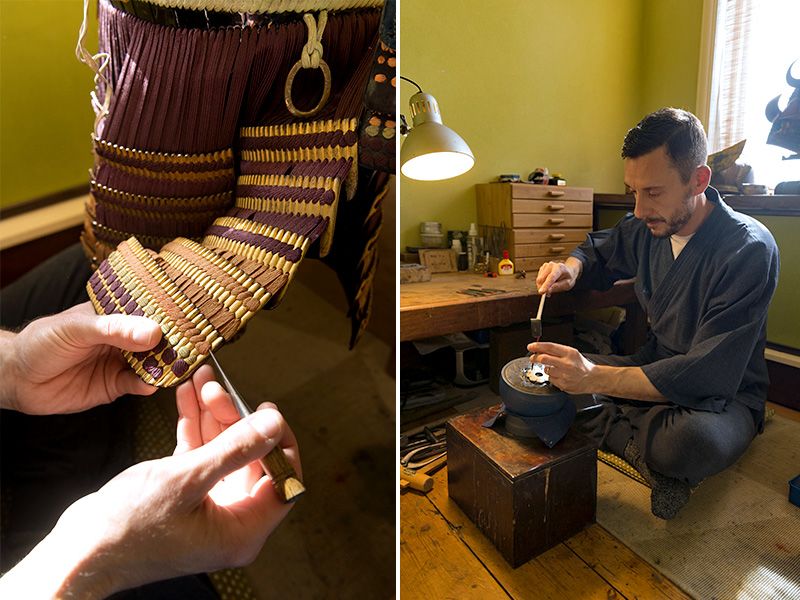 (Left) Soanes works on the lacing of a set of armor. (Right) Soanes works on the hachimanza, a metal piece at the top of the kabuto.
(Left) Soanes works on the lacing of a set of armor. (Right) Soanes works on the hachimanza, a metal piece at the top of the kabuto.
Just two years later in 2003 he was invited by his teacher Nishioka to work on the creation of a historic reproduction set of armor impressively named “Small Cherry Blossom Leather Laced Great Armor”. It is a replica of a Heian-period heirloom of the Takeda family of the Kai domain (modern-day Yamanashi Prefecture) and owned by the Yamanashi Prefectural Museum, where it is on display.
Soanes spent about one and a half months in Japan working on the piece with Nishioka and Nishioka’s wife, Chizuru, who is a specialist in kumihimo (lacing) and historic dyes. Soanes worked on the kanagumawari (main iron parts) and fukurin (soft metal edging), which were made from a special Japanese alloy known as kuromidō (copper containing roughly 1% arsenic). In all, six artisans participated in the restoration.
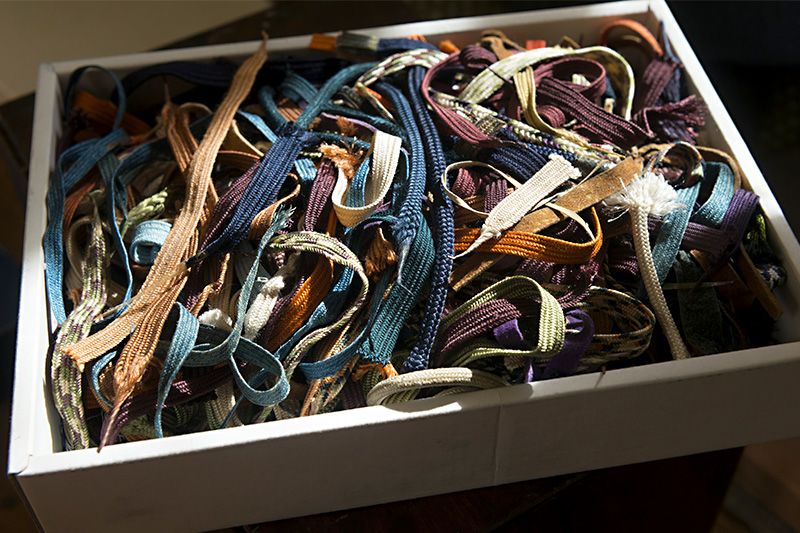 Himo straps used in the restoration of samurai armor.
Himo straps used in the restoration of samurai armor.
An Exquisite Array of Tools
Soanes buys all his materials and tools from Japan, either by mail order or in person on his occasional visits to the country. His workshop (no bigger than a small bedroom) is stocked with an exquisite array of implements: scissors, hammers, little bamboo tubes for sprinkling makie gold dust, and brushes for applying urushi lacquer.
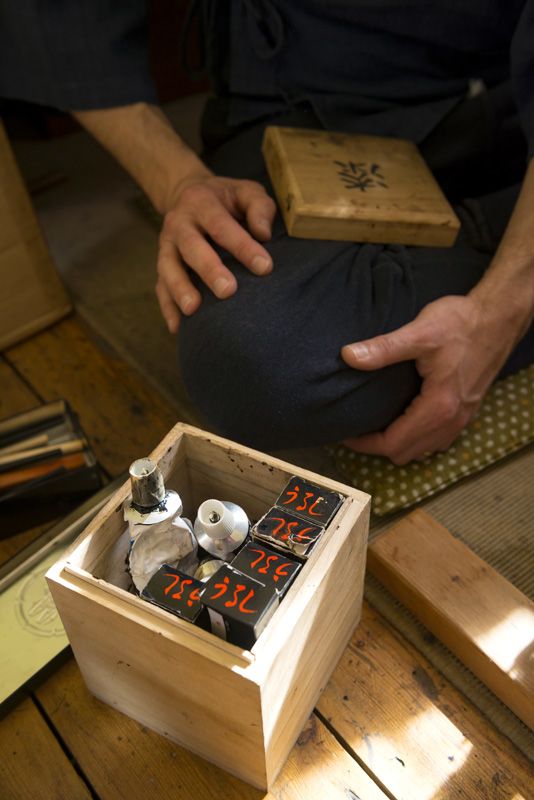 Urushi lacquer used in the restoration of samurai armor.
Urushi lacquer used in the restoration of samurai armor.
“The brushes are supposed to be made from the hair of pearl divers,” Soanes tells me. “They say that the salt strengthens the hair.”
Now in his mid-forties, Soanes has had a strong interest in Japanese culture for most of his life, ever since learning judo as a child. A thorough understanding of Japanese history is essential when working on centuries-old armor and swords, and the restoration must be historically accurate: not just the techniques and materials but also the correct patterns and motifs for the period.
Most of the armor that Soanes works on is from the Edo period. By the end of that time of relative peace in Japan, armor and weapons had become less practical weapons and more highly decorative family heirlooms. “Having a good set of armour would have been like having a Learjet today,” Soanes explains. “It was a status symbol.”
Armor would likely have undergone repairs while being passed down from father to son. Even if never used in battle, the leather and silk lacing holding the armor together would deteriorate. So a typical job for an armorer then (as now) was to remove the old lace and replace it with new.
Obsessive Pursuit of Authenticity
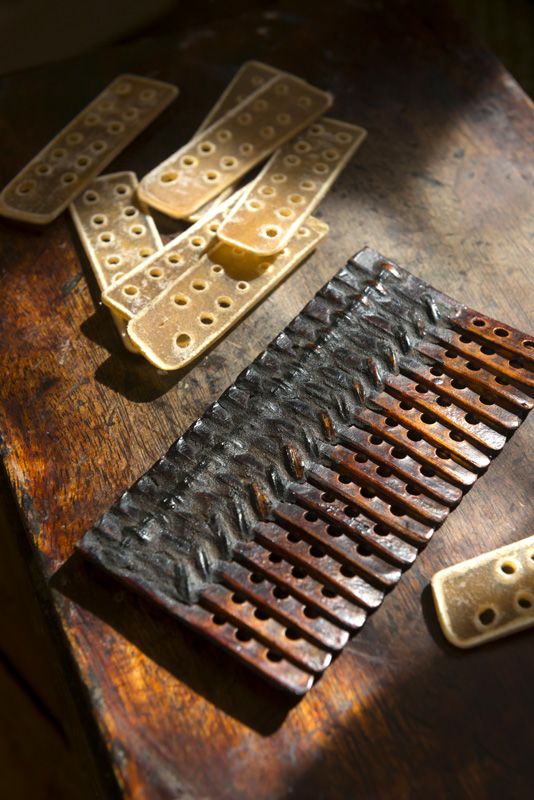 Leather scales for a set of armor.
Leather scales for a set of armor.
Soanes has his own martial heritage. On a window sill in the living room of Soanes’s home is a photograph of Soanes’s grandfather who is wearing the uniform of a major in the Coldstream Guards. Being from a military family and having an artistic bent helped draw him to his current career, he says.
It is a career distinguished by the near obsessive pursuit of authenticity and attention to detail. The armor he worked on with his teacher, for example, featured over 3,000 small rawhide leather scales called kozane. Each had to be coated with 10 layers of lacquer.
The challenge for the restorer is to use materials and methods as close as possible to the artisans of old, no matter how difficult or time consuming.
“I have often thought that if there is a hard way to do something, the Japanese will find it and use it,” says Soanes. But he says it with a smile, and I get the feeling that he is not complaining.
“You do it for the passion,” he says. “You do it for posterity.”
(Banner photo: Robert Soanes works on the hanchimaza, a metal piece at the top of the kabuto. © Tony McNicol)